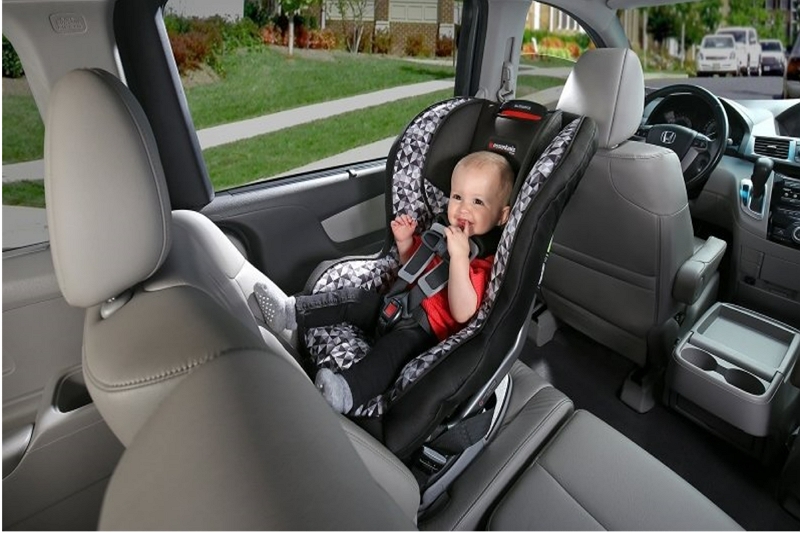When to put baby in convertible car seat? A convertible car seat is a type of baby carrier that can transition from a rear-facing infant mode to a front-facing, and eventually into the toddler position.
This allows for extended use. Convertible seats are often more expensive than other types of car seats because they grow with your child rather than being replaced every few years as he or she grows.

Convertibles typically weigh up to 30 pounds forward-facing but only 20 pounds rear-facing while an infant style safety seat will weigh about 12 lbs at birth and around 22 after six months when it’s time to switch over.
There are several options available on the market today for infants who have outgrown their first stage carriers such as compact seating systems which allow you to move them easily between vehicles or strollers.
When can you turn a car seat forward-facing?
Most children can ride forward-facing when they weigh between 20 and 40 pounds and are at least one year of age. Parents should consult their car seat’s instruction manual for specific recommendations about weight, height, or age.
Be sure to check the date your child outgrows a convertible seat before you buy another size; it may not be necessary if he is on the small side.
Also, remember that any rear-facing infant weighing more than 25 pounds needs to move into a front-facing harnessed seat because his head is too heavy for an upright position in a five-point harness (even though infants need extra support while facing backwards). This change usually occurs by 12 months of age but make sure this seat fits your car and uses the LATCH system.
At what age can a child use a 3 point seat belt?
A child should remain in a rear-facing car seat until the age of two, and then use a forward-facing car seat that is appropriate for their size. When children outgrow this type of car seat it’s time to move into booster seats because they are designed to be used with adult lap and shoulder belts.
Children can ride without boosters when they have reached at least 145 cm (about four feet nine inches) in height or at around 11 years old, whichever comes first. The three-point belt system holds them firmly but does not come across the neck so if there is an accident they will not be injured like adults might experience.
It also keeps them safe from flying through windows which could cause serious accidents while still keeping them attached to the car frame.
What kind of car seat should a 40 lb child be in?
A child should be in a forward-facing car seat that is either convertible or high-back for as long as possible. If the top of their head can pass the top harness slot, you will need to continue using a rear-facing car seat until they outgrow this height requirement which typically happens around 40 lbs or age two.
By then your baby will hopefully weigh well over 30lbs and there won’t be any question about them needing to ride in the front-facing mode because most convertible seats only go up to 50 pounds (forward) but I know some do allow babies up to 65lbs if used with an internal harness but these are few and far between so you’ll have plenty of time before switching into one of those at least! Just keep your eye on that top harness slot, they will hopefully be able to use it for a good year or two longer.
Does a 3-year-old need a 5 point harness?
A five-point harness is a type of child safety seat that consists of a lap belt and two shoulder belts. The three-point harness has only one shoulder strap, while the four-point harness adds an extra pelvic buckle which provides additional stability for booster seats or car seats used with them.
At what age can toddlers use booster seats?
Booster seats were created to provide a solution for children who outgrow their harnessed car seats. A child’s age and size is the deciding factor on when they should transition from a forward-facing car seat into a booster.
Some state laws require each person in your vehicle to use safety restraints such as lap belts, shoulder belts or a combination of both types of belts; however, these laws do not define how old or tall someone needs to be before using them safely.
It will ultimately depend on the height and weight of every individual child based on manufacturer recommendations which can vary depending on where you live or your own vehicles requirements if it has been modified with aftermarket products like side airbags/seatbelt tensioners.
What kind of booster seat does a 3-year-old need?
A child should be in a booster seat until they are at least four feet nine inches tall, or over the age of eight. The safest option is to keep your child in one until he/she has reached this height and weight limit, but it’s not like you can make them leave when that happens!
Does a 4-year-old need a harness?
Yes, a child harness should be kept on at all times while children are in the car. The reason for this is that it ensures kids stay put if they’re not properly buckled up during an accident or sudden stop.
